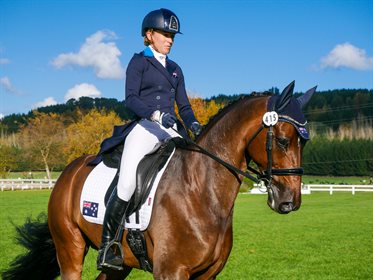|

|
This article first appeared in a previous edition of Equestrian Life magazine. To see what's in the current edition, click here.

Amanda Ross on the beautifully presented Dicavalli Diesel.
© Kirsty Pasto
At the Sydney Olympics, and more recently at the Australian Institute of Sport, I discovered a new activity I enjoy – dining hall athlete watching. It is vastly different to watching equestrians eat and something we can learn from.
BY AMANDA ROSS
THE FOOD HALL is the one place where all athletes converge and where you see firsthand what fuels are driving these amazing talents.
The equestrian athlete would be shot, hung and quartered if they ate their usual diet in front of the AIS nutritionists (even though our horses eat clean!). AIS athletes eat a properly considered, fully balanced and controlled diet. So, to save us from our own undoing, let's discuss navigating our way through nutrition.
Good nutrition WILL benefit your performance.
• Maintain energy for daily activities. We spend a lot of time feeding, carrying, leading, lifting and bending down before and after we ride.
• Optimise performance while training. The quality and quantity of our training produces the performance at comps. Withstanding repetitive practice and refining skills takes longer than one dressage test or jumping round.
• Improve and maintain your goal physique. Depending on your body composition, not all riders are about losing weight. There are guys who need to limit muscle bulk to reduce weight and increase flexibility, and there are young female riders who require more strength and conditioning.
• Maintain hydration. The body requires water to transport nutrients, expel waste, maintain body temperature and, critically, reduce physical and mental fatigue, and therefore the risk of injury.
• Competition day. We often have multiple events in one day, so consider the time of day, time available between events, gastrointestinal intolerance, available food at events, and storage of your own food.
• Recovery. Competitions can go for days, so what you eat at the end of one day of affects how you perform the next day.
How do we fuel our body?
The body has three fuel sources – carbohydrates, proteins and fats. The fuels used in anaerobic exercises – for example, sprinting – differ from those used in aerobic exercises – such as distance running. Glucose in the blood fuels every cell of the body.
Carbohydrates from food circulate in the blood as sugar. If insufficient carbohydrates are consumed to meet our fuel needs, then fats and even proteins are next to be converted into sugars – this is typical for endurance activities. However, when fats are converted to sugar in the absence of carbohydrates, byproducts called ketones are produced. These ketone molecules affect brain function in a fashion similar to alcohol, impairing decision-making ability, awareness and judgment.
Carbohydrates
A lot of pronouncements have been made about the detrimental effects of carbohydrates, leading to the emergence of low-carb fad diets. In reality, carbohydrates are an important source of fuel for physical activity, and vital for the proper functioning of various organs.
However, certain types of carbohydrates are more beneficial than others. Carbohydrates come in various forms: starches, sugars and cellulose, and are broken down and converted into glucose, or blood sugar, after they are consumed.
There are two types of carbohydrates: simple and complex. Foods are categorised as either simple or complex based on the speed at which sugar is broken down and absorbed by the body. Simple carbohydrates (e.g. fruits, milk and vegetables) are absorbed faster because they are made up of only one or two sugar units. Over-consumption of simple carbohydrates can lead to increased blood sugar levels, which can worsen metabolic conditions and lead to health issues.
Complex carbohydrates (e.g. brown rice, quinoa, beans, sweet potato and rye/barley/spelt bread) are the healthier carbohydrates, because the body takes longer to digest and absorb them, providing a more sustained release of energy and better appetite control. Carbs in a complete rider's diet should form around 50-65 per cent of their diet.
Proteins
The role of protein in the body is to grow and repair tissue and increase and maintain muscle mass. Unless you’re exercising like a body builder or triathlete, meeting protein needs through eating well is relatively easy, inexpensive and effective. What we call protein is, in fact, a family of amino acid molecules. When grouped together in various combinations, we get proteins.
Animal proteins such as eggs, lean meat, chicken, as well as seafood and dairy foods, contain all the essential amino acids needed to build proteins within the body. With the exception of dairy foods, most animal-based proteins contain few, if any, carbs, giving you a high percentage of your total calories from protein. Also, many protein-rich, animal-based foods are rich in zinc and iron, which is more readily absorbed than iron in plant-based foods.
Plant-based protein from foods such as soy, quinoa, other whole grains and legumes, as well as nuts and seeds, are more likely to have a lower intake of dietary cholesterol and unhealthy saturated fat. Proteins from soy and quinoa are classified as complete proteins because they contain all essential amino acids, much like proteins from animal-based foods. Vegetarian diets can result in lower body mass indexes, lower blood cholesterol and lower blood pressure levels if care is not taken. You can still obtain all the essential amino acids by eating a variety of plant proteins during your day. Aim for 15-20 per cent protein in your daily rider's diet.
Fats
Fats are essential for good health and are twice as calorie-dense compared to carbohydrates or protein. Fats are mainly stored in the body’s adipose tissue and are classified as saturated, polyunsaturated or monounsaturated. Our bodies produce both monounsaturated and saturated fats. Polyunsaturated fats, or essential fatty acids, cannot be produced in the body and must come from the diet. Monounsaturated fats are normally found in olive and canola oils. Saturated fats are found in animal products such as butter, cheese, whole milk, ice cream, cream and fatty meats, as well as some vegetable oils – coconut, palm, and palm kernel oils.
Many processed foods and fast foods are high in saturated fat. Polyunsaturated fats are found in safflower, sunflower, corn, and soybean oils.
Fat is essential for energy production and to insulate the body and cushion vital organs. Fat helps build new cells and is critical for brain development and nerve functions. Fat also carries and helps absorb fat-soluble vitamins such as A, D, E and K, without which our immune functions, eyesight, and blood-clotting ability would be compromised.
Daily fat intake should be15-25 per cent of calorie intake, coming mostly from sources of polyunsaturated and monounsaturated fatty acids such as fish, nuts and vegetable oils. Therefore, getting the balance is essential – the less fat that riders store in their body tissue, the more athletic they are likely to be on their horses. Next time you go to the canteen, consider the fat content of burgers with butter and bacon, hot chips/potato cakes, donuts, chips … just imagine rubbing that straight onto your bum/thighs/love handles as you pull on your (extra tight) breeches and prepare to ride your (puffing, heaving) cross-country round! Not exactly an AIS approved pre-comp prep!
Essential nutrients and hydration
For athletes to perform best, they need to be well hydrated and to replace electrolytes lost through sweat and urine during exercise.
Magnesium is a critical electrolyte, along with potassium, sodium and chloride. Low levels of these nutrients are associated with an increased incidence of muscle cramps. Aside from water alone, commercial electrolyte supplements are useful when riding all day or in hot conditions, and coconut water is an excellent source of potassium in particular – look for the organic, no added anything variety. And consider examining your own urine colour … we all know dark urine in horses means dehydration, so the same goes for the rider!
My competition kitchen rules
To combat comp day nerves, busy early starts and jiggly sitting-trot, I opt to graze on small, grab-and-go snacks through the day. Here are some of my favourites:
• Breakfast – small yoghurt, or a banana, handful of raw nuts.
• Snacks – cherry tomatoes, mini cucumbers, carrots with avocado dip or tatziki, plus rye pita bread.
• Dinner – Brown rice, tuna or tofu, broccolini, bean shoots and chilli with Tamari sauce (organic soy sauce). Water, coconut water, Endura sports drink (mixed in a water bottle and kept in ice with the horse's ice boots!)
READ THE LATEST NEWS ARTICLES HERE

|

|

